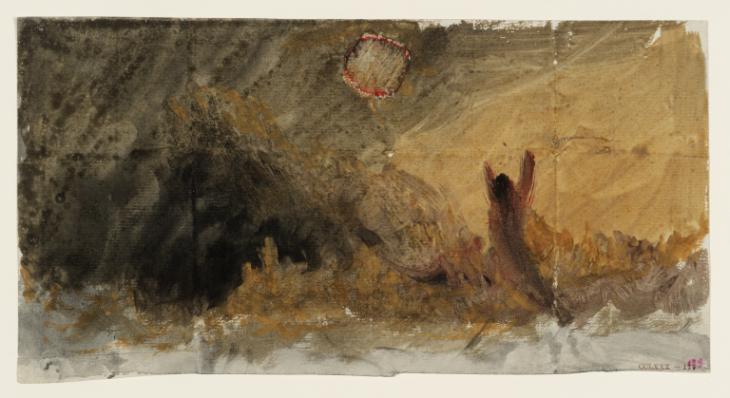Joseph Mallord William Turner ?Study for the 'Vision of Medea' c.1824-8
Joseph Mallord William Turner,
?Study for the 'Vision of Medea'
c.1824-8
Joseph Mallord William Turner 1775–1851
?Study for the ‘Vision of Medea’ c.1824–8
D27656
Turner Bequest CCLXXX 139
Turner Bequest CCLXXX 139
Gouache on white laid paper, 120 x 227 mm
Blind-stamped with Turner Bequest monogram below right of centre
Inscribed in red ink ‘139’ bottom right
Stamped in black ‘CCLXXX – 139’ bottom right
Blind-stamped with Turner Bequest monogram below right of centre
Inscribed in red ink ‘139’ bottom right
Stamped in black ‘CCLXXX – 139’ bottom right
Accepted by the nation as part of the Turner Bequest 1856
Exhibition history
1998
Turner and the Scientists, Tate Gallery, London, March–June 1998 (48, as ‘Eclipse, with a Gesticulating Figure’, 1824, reproduced).
References
1826
A.J. Finberg, A Complete Inventory of the Drawings of the Turner Bequest, London 1909, vol.II, p.899, CCLXXX 139, as ‘A vision’, c.1826–36.
1993
Jan Piggott, Turner’s Vignettes, exhibition catalogue, Tate Gallery, London 1993, p.96 Appendix A, as ‘Not a vignette. ?Medea’.
1998
James Hamilton, Turner and the Scientists, exhibition catalogue, Tate Gallery, London 1998, pp.61, 63, 139 no.48, as ‘Eclipse, with a Gesticulating Figure’, 1824, fig.58.
This small but dramatic study was placed somewhat arbitrarily by Finberg in the middle of the ‘Studies for Vignettes’ of about 1826–36 in his 1909 Inventory, where he called it ‘A vision’.1 Intentionally or not, this evokes the title of the large mythological painting of the Vision of Medea, exhibited (probably unfinished) during Turner’s prolonged stay in Rome in 1828 and again at the Royal Academy in 1831 (Tate N00513).2 In that composition the principal figure is on the left with her arms raised in incantation, with a dark cave-like area between trees to the right and floating bubble-like forms among other supernatural emanations in between.
It is possible that this is an early idea for the scene, prompted by Turner’s readings in the classics and also perhaps by the successful 1826–7 London production of J.S. Mayr’s opera Medea in Corinto.3 Jan Piggott was the first to make a tentative connection with the subject, noting Turner’s use of the back of an envelope (see the technical notes below), utilising the ‘red rim of [the wax] seal as [the sun]’,4 although the sun does not feature in the completed design. In the context of Turner’s interest in astronomy and the sun in particular, James Hamilton reads this study as ‘a nude figure, perhaps surrounded by dozens of others, gesticulating at the eclipsed sun. This is painted on the patch left by the wax seal, and the whole work compares with the apocalyptic pictures of John Martin’ (1789–1854).5
Given Turner’s loose handling in this informal design, with its rough forms and relatively muted colours, it is difficult to establish whether his development of the existing circle was intended at this stage as a visionary bubble, the occluded sun or even perhaps a dim full moon. Developing Hamilton’s point, and given the sometimes punning nature of Turner’s associative thoughts, it is perhaps even possible that the opening of the sealed letter had brought to mind the apocalyptic Biblical episode of the opening of the Seven Seals in the Book of Revelation;6 compare the subject matter of the late painting The Angel Standing in the Sun, exhibited at the Royal Academy in 1846 (Tate N00550),7 and see under Tate D27595 (Turner Bequest CCLXXX 78) in the present section.
The verso, bearing only the artist’s name and address and an 1824 watermark, is Tate D40317. The range date assigned here assumes a connection with the 1828 painting as a possibility.
Technical notes:
The sheet was originally an envelope, folded horizontally above the centre and vertically about a quarter and three-quarters of the way across. Its wax seal was removed at the top centre, presumably on opening, leaving traces which Turner exploited in his composition.1
Matthew Imms
August 2016
How to cite
Matthew Imms, ‘?Study for the ‘Vision of Medea’ c.1824–8 by Joseph Mallord William Turner’, catalogue entry, August 2016, in David Blayney Brown (ed.), J.M.W. Turner: Sketchbooks, Drawings and Watercolours, Tate Research Publication, February 2017, https://www

